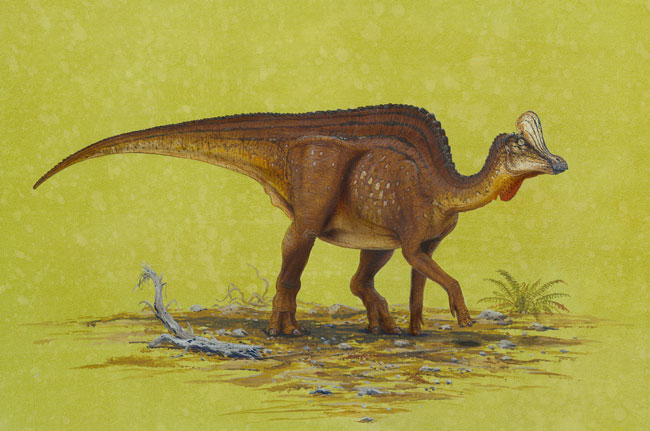New Duck-Billed Dino Discovered in Mexico

A new species of duck-billed dinosaur unearthed in Mexico is helping scientists fill in gaps in the fossil record of the Age of Dinosaurs.
The creature, dubbed Velafrons coahuilensis, was a massive plant-eater belonging to a larger group of duck-billed dinosaurs called hadrosaurs.
The dino's species name comes from the region of Mexico where it was found, Coahuila. Little is known about the region's ancient animal and plant life because low rates of erosion have kept fossils hidden under layers of rock. But V. coahuilensis and other fossil finds are helping to shed light on this murky part of North American history.
"Dinosaurs from this particular period are important because this is a time that is relatively poorly understood," said Don Brinkman, a project researcher from Canada’s Royal Tyrrell Museum of Paleontology who is studying the non-dinosaur vertebrates found at the site, including turtles, fish and lizards. "The locality in Mexico goes a long way to filling in a gap in our knowledge of the record of changes in dinosaur assemblages throughout the Late Cretaceous era."
The new species of dinosaur is fully described in the December issue of the Journal of Vertebrate Paleontology.
Split continent
V. coahuilensis, one of the first dinosaurs to be named from Mexico, was discovered in the early 1990s in a rock unit known as the Cerro del Pueblo Formation, which dates from about 71.5 to 72.5 million years ago, in the late Cretaceous.
Sign up for the Live Science daily newsletter now
Get the world’s most fascinating discoveries delivered straight to your inbox.
During this period, a warm, shallow sea covered the central, low-lying portions of North America, splitting the continent in two.
The region of Mexico where V. coahuilensis was found was at the southernmost tip of the peninsula-like western landmass, called Laramidia. Now a desert, the area was then a humid estuary, where ocean saltwater met freshwater from rivers.
Large bonebeds of jumbled dinosaur skeletons suggest some of the animals died en masse during periodic powerful storms, like those that pummel the southern tips of Africa and South America today.
"The region was periodically hammered by monstrous storms, devastating miles of fertile coastline, apparently killing off entire herds of dinosaurs" said project team member Scott Sampson of the Utah Museum of Natural History.
North American first
The discovery of V. coahuilensis marks the first crested duck-billed dinosaur ever found in North America. Based on the development of its bones, paleontologists think the specimen was not yet fully grown. Still, the youngster would have spanned an imposing 25 feet in length, suggesting adults grew to a whopping 30 to 35 feet long.
Unlike other animals whose nose bones lie in front of their eyes, crested duck-bills' noses rested atop their skulls.
"The crested duck-billed dinosaurs are an extraordinary example of vertebrate evolution," said project member Terry Gates, also of the Utah Museum.
Scientists are unsure what the fan-shaped crest on V. coahuilensis's head was used for, but some think it could have been for attracting mates, with the animal's complex series of nasal passages acting like a musical instrument.
Along with V. coahuilensis, recent expeditions to the Cerro del Pueblo Formation have uncovered the remains of a second kind of duck-billed dino — a Triceratops-like plant-eating horned dinosaur, large tyrannosaurs, small Velociraotor-like predators and the largest assemblage of dinosaur tracks known in Mexico.
- Avian Ancestors: Dinosaurs That Learned to Fly
- A Brief History of Dinosaurs
- Images: Dinosaur Fossils

Andrea Thompson is an associate editor at Scientific American, where she covers sustainability, energy and the environment. Prior to that, she was a senior writer covering climate science at Climate Central and a reporter and editor at Live Science, where she primarily covered Earth science and the environment. She holds a graduate degree in science health and environmental reporting from New York University, as well as a bachelor of science and and masters of science in atmospheric chemistry from the Georgia Institute of Technology.









